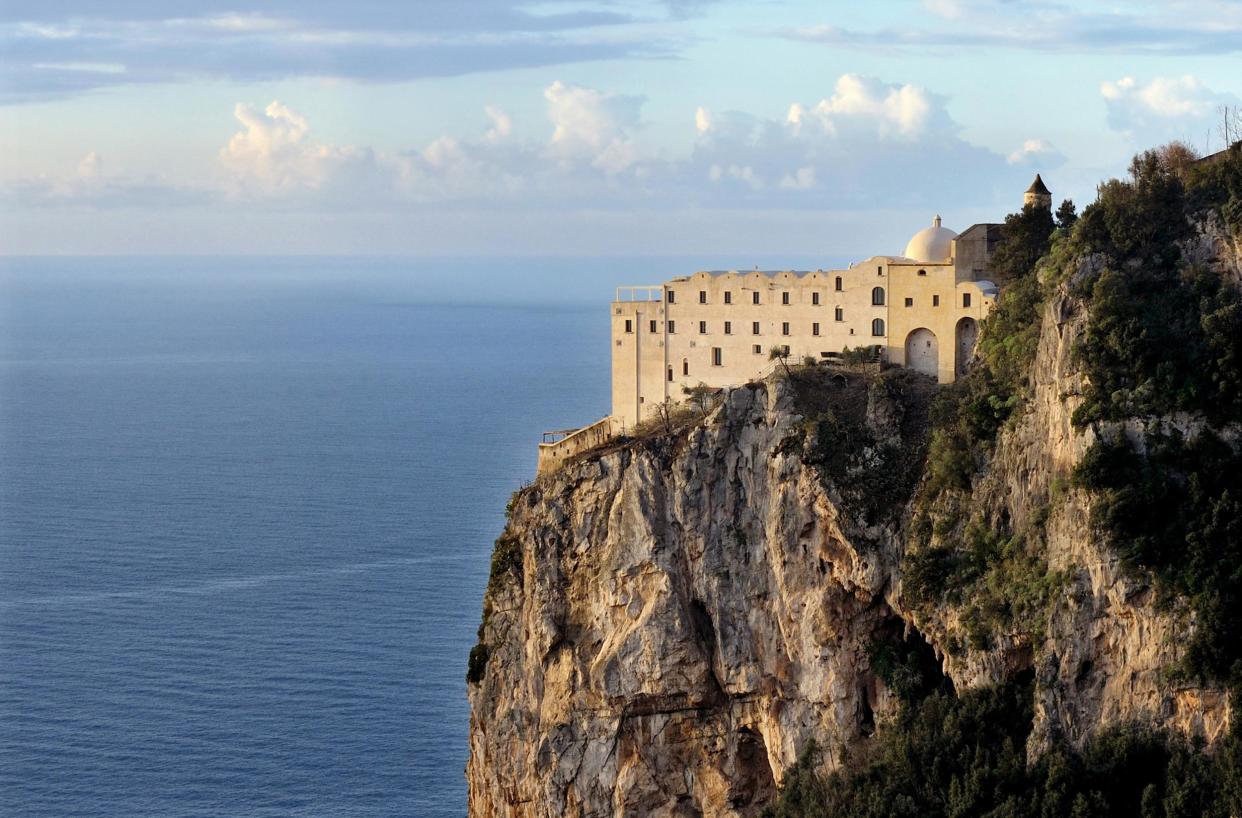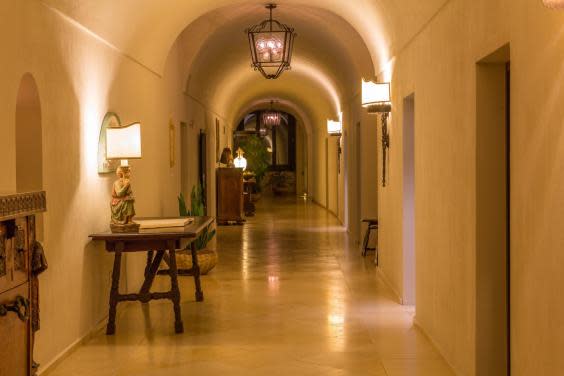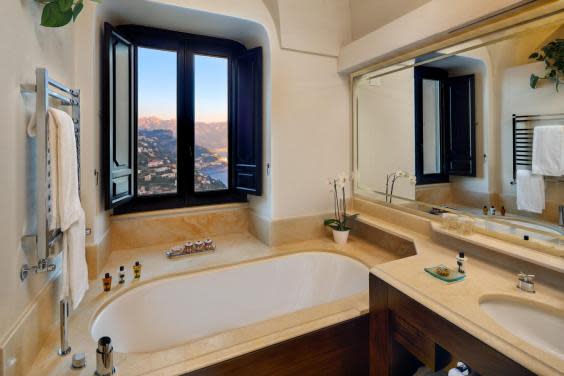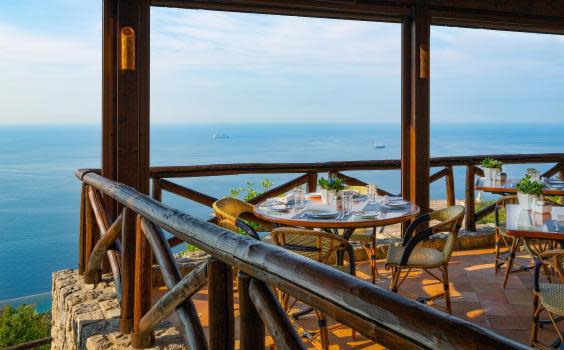Monastero Santa Rosa: Stay in a converted monastery on the Amalfi coast

In a nutshell: A dramatically converted former monastery overhanging a cliff on the Amalfi coast
Some hotels are more than just places to lay your head. As I pull up to Monastero Santa Rosa, built directly into the cliffs of the pint-sized village of Conca dei Marini, after a zig-zaggy drive through the mountains of Parco Regionale dei Monti Lattari from Naples, a church bell tolls as I walk through what would have been the entrance to the 17th-century monastery. Behind: the church of Santa Maria di Grado. Straight ahead: the blue, blue sea of Salerno Bay, stretching out like tarpaulin from a tiny balcony. To the right: a heavy iron bell that hides a cool glass of welcome lemonade, made from – of course – traditional Amalfi lemons. To the left: the glass door that leads to the guest rooms, decorated with wrought iron handles in the shape of a nun, reflecting the monastery’s one-time residents.
Is monastic luxury a thing? It is here, at this delightfully imposing hotel, which stands like an architectural totem on the coastal journey between the typical coach stops of Positano and Amalfi. Ever wanted to bed down like a nun? Then Monastero, for short, is the hotel for you.
The neighbourhood
Monastero clings to the tiny cliffside village of Conca dei Marini, a five-minute drive from the town of Amalfi, where there’s far more to occupy visitors. There’s the chandeliered, mirrored coffee bar Andrea Pansa, which sits below the steps to the town’s striped marble and stone Duomo, plus plenty of boutiques selling capodimonte crockery and the traditional paper that this area is known for. Twenty minutes in the other direction is pretty but touristy Positano, home to lemon shops and tiered restaurants cascading down to the beach.
The look

A delicate balance between 21st-century modernity and 17th-century ecclesiastical heritage. American owner Bianca Sharma, who bought the hotel after seeing it from a boat in 2000, has overseen a frankly unimaginable renovation of this vast stone behemoth, during which time architects, engineers and historians transformed this sand-coloured stone monastic palace into a luxury one. However impressive the transformation, there are still echoes of the past, when this vast building was inhabited solely by nuns. A cubbyhole halfway along the tunnel-like corridor to the guest rooms hides a frayed prayer chair, which acted as a confession box (the other side opens into the church next door); plus a giant wooden chest that the nuns used to keep their habits has been repurposed as a gigantic side table. That’s inside.
The grounds are a different story. Where the hotel feels church-like, the tiered gardens throws everything wide open. Four levels, stuffed with rosemary, lemons and bougainvillea, with lounge chairs dotted about at optimum angles, stare straight into the Bay of Salerno, before dripping down to the shallow, perfect-for-posing infinity pool.
The vibe
Spiritual, but thankfully not in an incense candle woo-woo way. Tip-toeing through the gently lit, cave-like stone-floor corridors first thing in the morning, passing the wooden confession boxes, feels pretty special.
The quietness is helped by the fact there are only 20 (generously sized) rooms at Monastero, and amid the gardens, you could wheel around the hotel for most of the day without bumping into other guests.
This ecclesiastical feel is further amplified by a private visit to the Santa Maria di Grado chapel next door. It technically belongs to the town of Conca, but the hotel has a key to allow for moments of quiet reflection.
Bed and bath

The 20 bespoke bedrooms are sweetly named after herbs the nuns used for making medicine from the gardens – salvia, calendula, rosa – and are just as pretty inside, with handpicked antique furniture either from the monastery itself or from wider Italy.
Rooms follow a lush design scheme that complements the whites, blues and yellows of the Amalfi coast, with crisp linens, stone floors, deep navy throws and walnut wood shutters designed to maximise the views of the sea. Truly plush bathrooms come decked out with heated floors and deep baths next to the window for eye-popping views; while the do not disturb signs are some of the most charming I’ve ever seen: impressionist hand-painted ovals depicting a nun’s face.
Food and drink

Unsurprisingly for one of Italy’s leading hotels, food is held in high regard at Monastero. The in-house restaurant, Il Refettorio, has one Michelin star and takes its mission to highlight the very best cuisine from the Campania region seriously. Fresh seafood, delivered by local fishermen, just-picked vegetables and herbs from the garden and what must be the most unctuous olive oil south of Rome make up the menu at this stunner of a restaurant, which spreads from the crypt-like stone space inside, out to the alfresco terrace with views over the bay. Fun fact: the wrinkled, flaky sfogliatella pastry (usually stuffed with ricotta, almond and orange peel) was invented in the monastery four centuries ago. They taste just as good for breakfast now as they did then.
There’s a small bar that opens into a lounge (stocked with fashion magazines, design books and more quirky art) on the lower terrace level.
Pools, spas and public areas

The hotel’s public areas cascade down from the entrance hall. There’s a kidney shaped infinity pool overhanging the cliff that would make influencers drool; a thermal spa that has retained the original 17th-century vaulted ceilings, all lit with candles; and four layers of beautiful gardens scented with the monastery’s herbs. The highlight is the roof terrace, where easy-breezy lounge seats are arranged on a rectangle of stone that looks out over Amalfi.
Nuts and bolts
Room count: 20.
In the bathroom: Products from Ortigia, a Sicilian soap and fragrance company.
Wifi: Free and fast.
Minibar charges: Yes.
Disability access: There is a lift from reception to the bar level, and some rooms offer disabled access, but in general this is not a hotel geared up for disabled travellers.
Pet policy: Not allowed.
Bottom line
Best thing: The jaw-dropping views – there’s nothing between the hotel and views out towards the Bay of Salerno, and watching the sun lancing off the sea in the morning while eating breakfast is nothing short of spectacular – and the ability to get lost wandering its gardens.
Worst thing: The drive through the mountains from Naples to get here is vomit-inducing. Plus, you’ll have to rely on the hotel’s shuttle to leave.
Perfect for: Honeymooners.
Not right for: Families, given that Monastero is adults-only.
Instagram from: The drinks terrace on the top floor, otherwise known as sunset terrace, when the sun starts to set. The best thing: hidden away in a discreet cupboard is a phone to call for drinks from the yellow lounge seats.
Room rate: From €400 (£343), B&B.
monasterosantarosa.com


